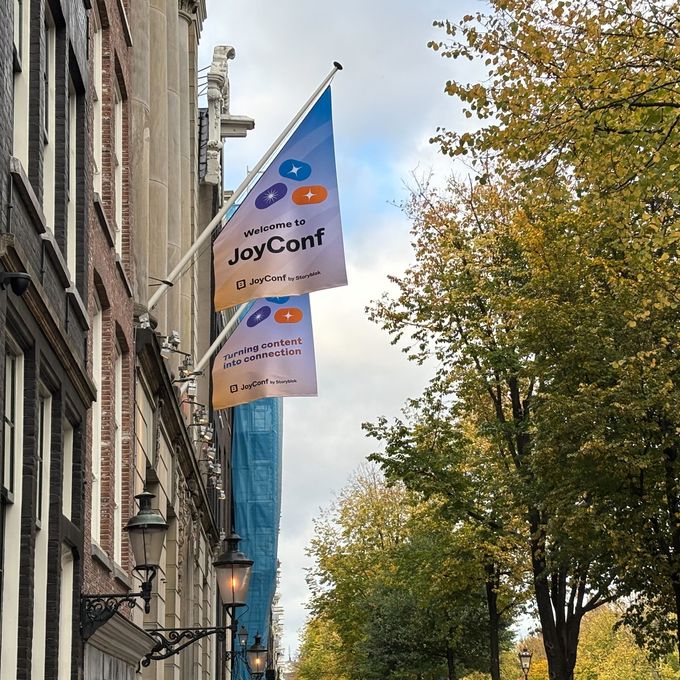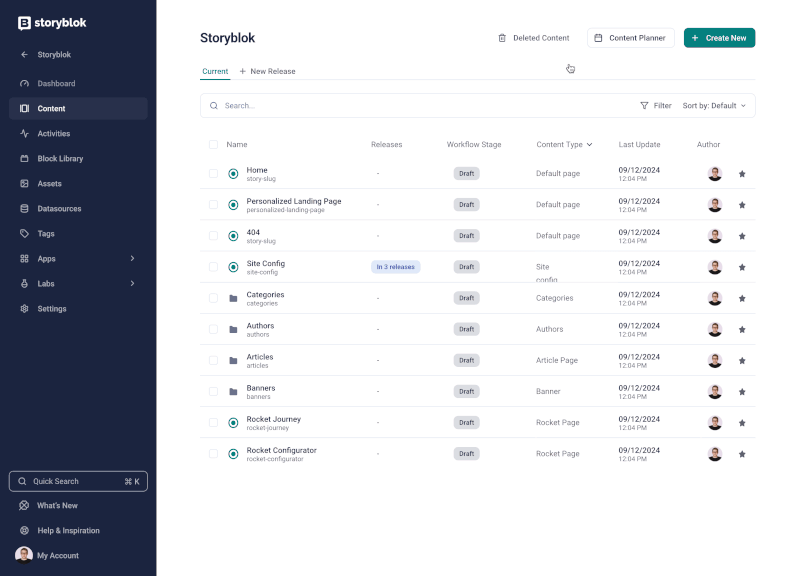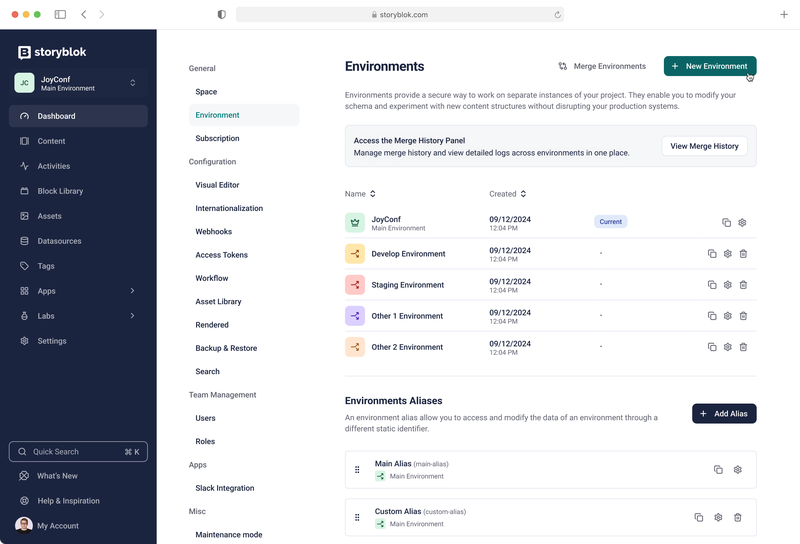
Is this the future of Headless CMS?
What we learned at Storyblok JoyConf and why it matters for brands.
Earlier this month I was in Amsterdam for JoyConf, Storyblok’s first-ever event for developers, marketers and brands. We didn’t really know what to expect, but we were blown away by it.
The event ran over three days, with the first dedicated to Storyblok Partners. Anything was proud to attend as both a Partner and Sponsor, and even more delighted to be named UK & Ireland Partner of the Year. It was a brilliant way to kick things off before diving into two days of talks, demos and discussions about where content is heading next.

There was a real buzz throughout the event. The speaker lineup included names from Netlify and Virgin Media O2, and the conversations felt genuinely forward-looking. Rather than dwelling on falling pageviews or the changes AI is bringing to search, there was optimism about the role of websites in an AI world and how this shift is actually a huge opportunity for brands that get it right.
From the opening keynote, Storyblok Co-Founder and CEO, Dominik Angerer made it clear this wasn’t just about product updates. As AI becomes the new gateway to the internet, content now needs to work for both humans and machines and Storyblok’s roadmap showed exactly how they’re preparing for that shift.
Over the course of the event, we saw a wave of new features that reimagine what a CMS can be. From Strata and FlowMotion to OtterlyAI, the Enterprise Content Planner and Environment Spaces, each one moves Storyblok closer to becoming a true content system built for the AI era.
Here are five announcements that really stood out to me, and that I can’t wait for our team at Anything to start using.
1. Content that understands context
One of the biggest announcements was Strata, and it really grabbed my attention. It introduces a new structured layer that gives content meaning and context. In simple terms, it helps your content understand itself.
Rather than treating each page or component as a standalone block, Strata connects everything together so Storyblok knows how your content relates. It understands what belongs where, what supports what, and how topics, products and resources link together.
We are still getting our heads around all the possibilities because it has so much potential. The idea of content that understands itself and the relationships between everything you create could change how teams plan, structure and personalise websites completely.
That might sound technical, but the result is something very human. It means when someone lands on a page, the system already understands their intent and can bring in the most relevant information automatically. Imagine a visitor reading about an electric van, and being shown the perfect case study, specification sheet or sustainability story without you having to manually connect it all.
For large brands managing global sites, this could be huge. It makes it easier to structure and reuse content, but it also sets the foundation for more intelligent and personalised experiences. In a world where AI tools are deciding what gets seen, content that understands its own context is what will stand out.
With Strata, brands can quickly identify and eliminate content debt, create new content that’s on brand, improve AI access and understanding, and deliver personalization at scale.
Dominik Angerer
CEO at Storyblok
2. Content that’s discovered and trusted
The integration of OtterlyAI into Storyblok is one of the updates I’m most excited about. It’s quickly becoming the go-to tool for understanding how AI sees and interprets your content, and it’s improving fast.

OtterlyAI gives you a clear view inside Storyblok of how your pages perform across AI search. It shows what’s visible, what’s missing and what can be improved, helping you master visibility before you hit publish. The deep integration means you can optimise your content while you create it, rather than trying to fix issues later.
As AI platforms like ChatGPT, Perplexity and Google’s AI Overviews reshape discovery, this kind of observability will be crucial. It’s no longer about chasing rankings. It’s about making sure your content is accurate, complete and trusted enough to be surfaced by AI systems.
For me, OtterlyAI feels like the start of a new way of working. It bridges creativity and visibility in a way that makes perfect sense for where the web is heading. And the fact that it sits natively within Storyblok makes it all the more powerful.
3. Content that flows intelligently
FlowMotion really caught my eye because it tackles something every team struggles with: keeping content flowing smoothly from idea to publication. Content is meant to move, but in reality, the workflows behind it are often slow and disconnected. FlowMotion changes that.
It connects Storyblok with the other tools you already use, so updates, translations and approvals can happen automatically without the constant back-and-forth. It’s powered by n8n, which is something our team at Anything are already huge fans of. We use it regularly to automate workflows and link systems together, so seeing Storyblok integrate it directly is really exciting. It means teams can design smart, reliable content flows inside Storyblok without needing complex third-party setups.
The beauty of FlowMotion is that it doesn’t just save time. It brings consistency and visibility to the whole process. You can set up workflows that match how your teams actually work rather than forcing everyone into rigid steps or endless approvals.
I can see this making a huge difference for brands publishing across multiple regions or languages. Imagine creating new content and seeing the assets, updates and translations flow through the system automatically while still keeping control over what goes live and when. It feels like a big step towards true content operations, where teams can focus more on ideas and less on coordination.
4. Content that’s planned with clarity
Storyblok has always been strong when it comes to release management. The ability to bundle up content changes, preview them together and schedule them to go live at the same time has been a big advantage over other CMS platforms. It makes planning launches, campaigns and updates much easier.

The new Enterprise Content Planner builds on that strength and adds a new layer of clarity. It gives every team a single shared view of what’s being created, reviewed and published, all in one place. For larger organisations or multi-market brands, that kind of visibility is game-changing.
Instead of juggling spreadsheets or relying on different people’s calendars, teams can now see the bigger picture. Campaigns, content updates and approvals are all mapped out clearly so everyone knows what’s happening and when.
What I really like about this update is that it tackles the part of content management most systems overlook the planning that happens before publishing. It’s designed for how teams actually work, bringing together marketing, content and design into one shared view.
For brands, this means less guesswork and better coordination. You can see exactly what’s coming up, who’s responsible and where things are in the process. It takes the strength of Storyblok’s release functionality and gives it the structure and transparency large teams need.
5. Content that scales safely
The developer in me finds Environment Spaces exciting, but it’s something everyone will end up appreciating. It’s all about giving teams more control, freedom and confidence when scaling content. I have a feeling that once we start using it, we’ll wonder how we ever worked without it.

It lets you manage multiple environments inside Storyblok, such as development, staging, localisation and production, all from one place. It means teams can test, learn and experiment without ever putting live content at risk. You can try out new components, explore layout changes or onboard new team members safely, knowing nothing will accidentally break the live site.
What I like about this update is how much sense it makes. Anyone who has worked on a busy site knows how easy it is for one small change to cause a big problem. This solves that by giving developers, editors and designers their own space to build, test and validate before anything is released.
It’s great for big brands too. You can test different content structures for each market, run A/B experiments or refine new components without adding complexity or needing extra CMS instances. It is a much smarter and safer way to scale, and it gives teams the confidence to move faster.
For agencies like ours, it also makes onboarding and collaboration easier. New developers and editors can get hands-on with real setups without touching the live site. It is one of those updates that feels simple but will make a huge difference day to day.
An amazing few days with an incredible partner
After three days in Amsterdam, it is hard not to feel excited about where Storyblok is heading. Each of these updates builds on what already makes the platform great, but together they mark a real step forward. It is no longer just about managing content. It is about connecting it, automating it and making it work intelligently across every channel.
We also had a lot of fun. From meeting other Storyblok Partners to chatting with developers, marketers and some of the biggest brands in the world, the energy throughout JoyConf was incredible. It was a reminder of how strong and supportive the Storyblok community really is.
As a team, we left feeling inspired and full of ideas for how we can use these new features in our projects. Strata, FlowMotion and Environment Spaces are updates that will genuinely change how teams work, and once we start using them I think we will all wonder how we ever did without them.
A huge thank you to the amazing team at Storyblok, who always treat us like true partners and make working together such a pleasure.
So, is this the future of Headless CMS?
Absolutely.